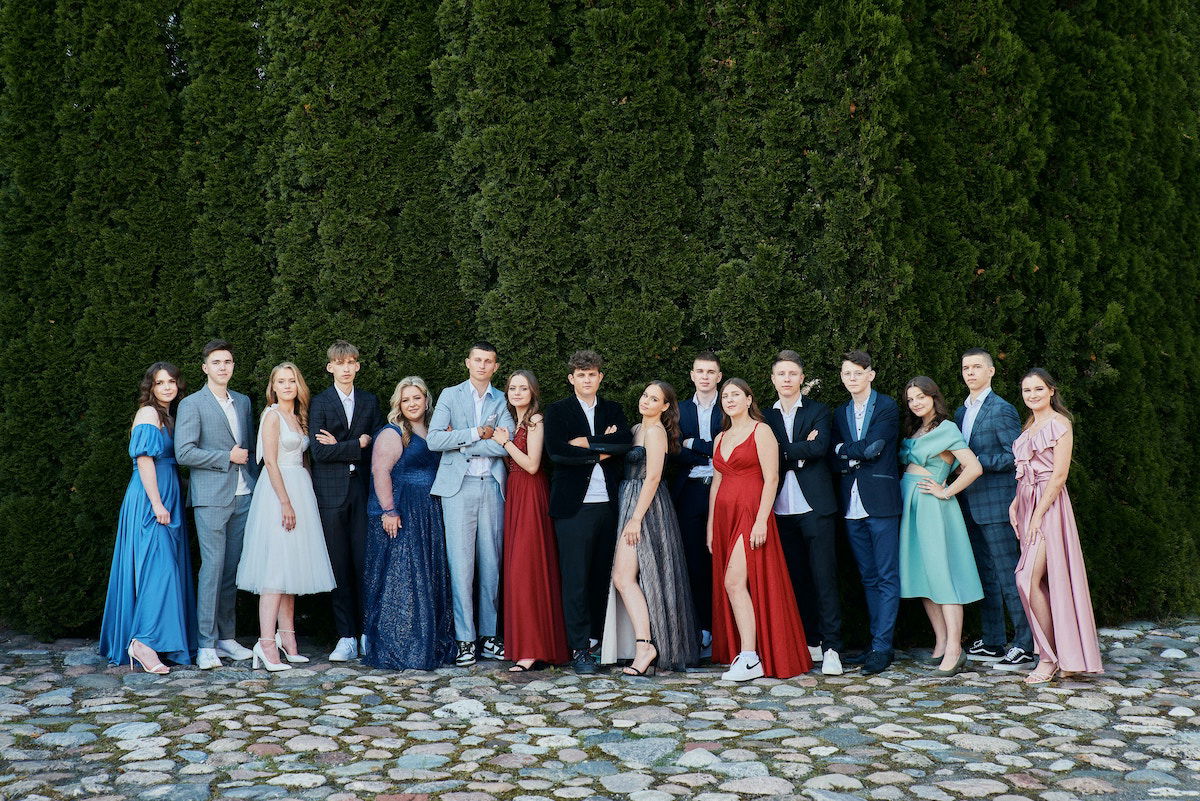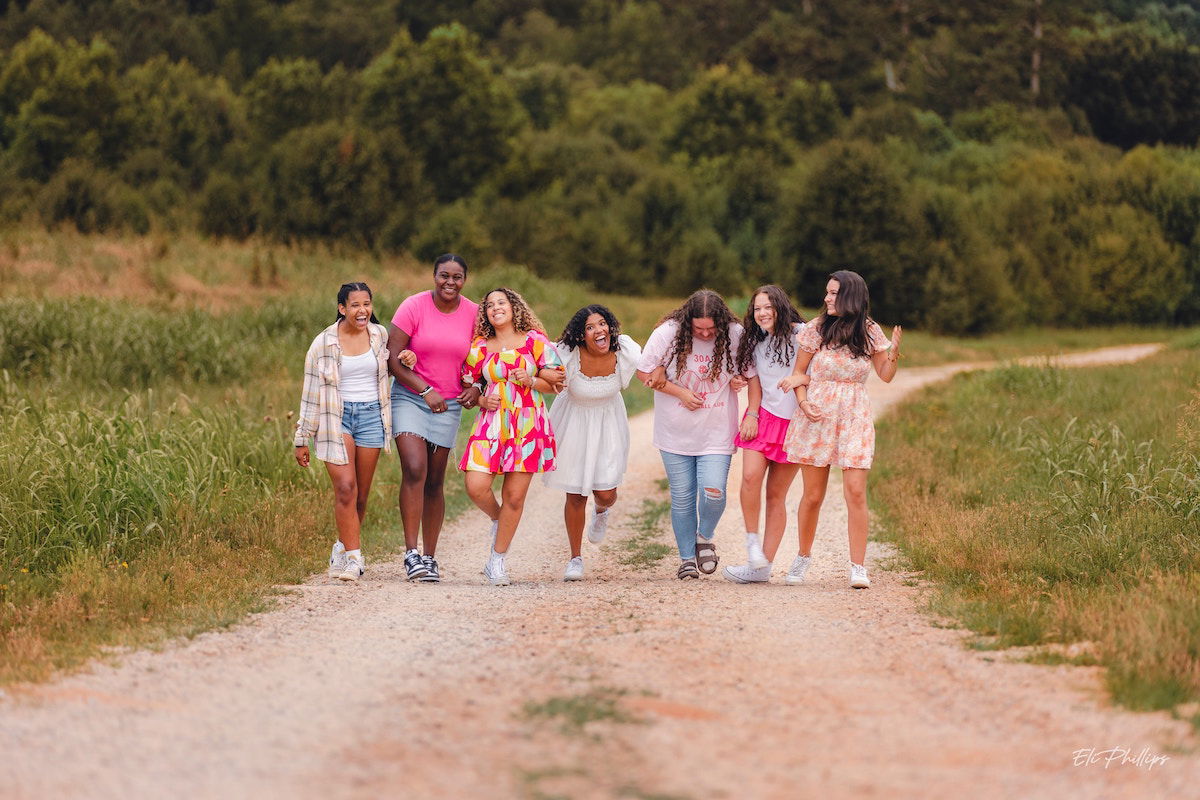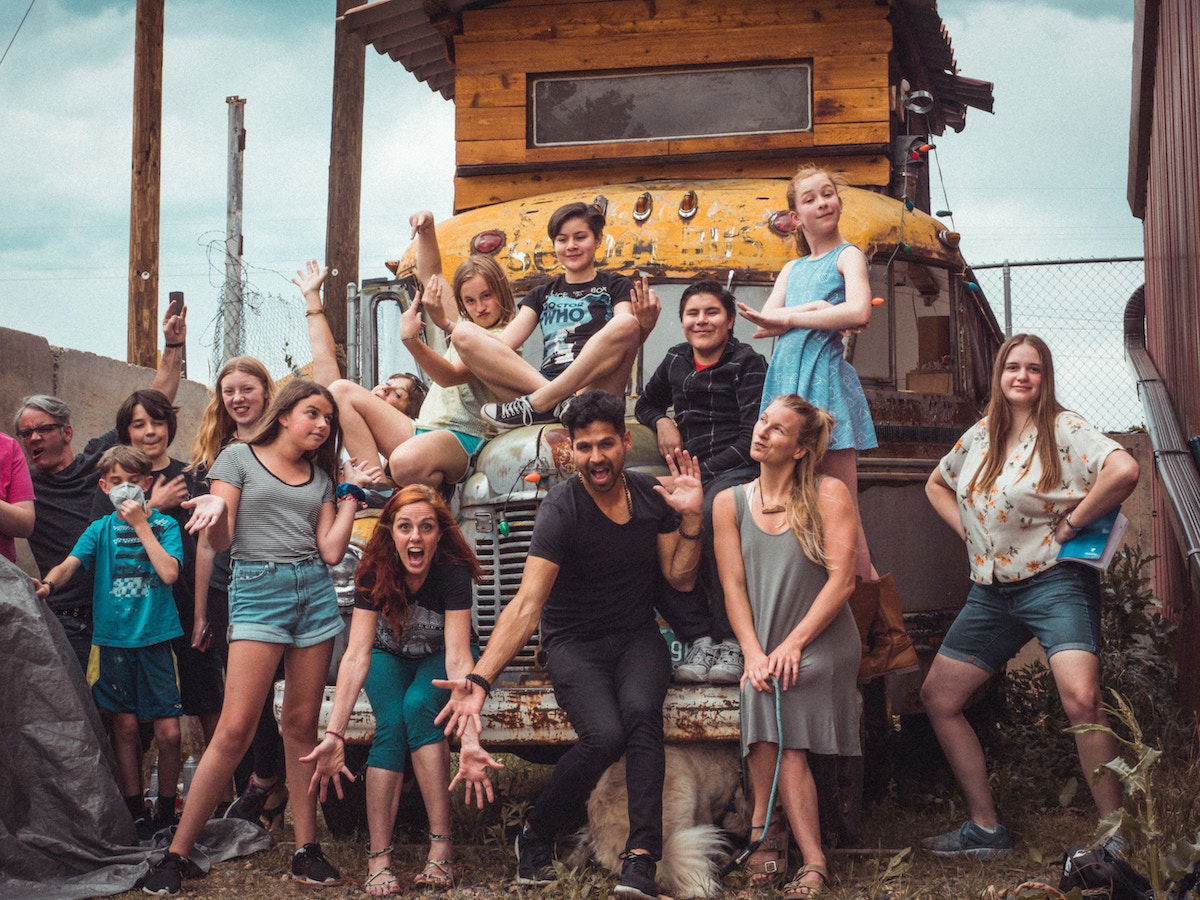Having trouble getting everyone in focus when taking group photos? It’s a common problem, but one that’s easy to resolve.
I still remember the panic rising in my throat after taking my first formal group photo. It was a team photo for a local sports program.
The back row turned out blurry. I had no idea why. Since then, I’ve learned that the answers are a lesson in aperture and a camera focus trick.
Our article shows you exactly how to take large group photos with everyone in focus. Whether it’s a family reunion or a sports event, you’ll be able to capture the whole team with everyone in perfect focus.
Focusing your camera for a group photo doesn’t involve any special equipment. You need the typical gear for group and family photos. But it’s essential to understand two basic elements of photography: aperture and depth of field.
We’ll take some time to help you understand these two principles before looking at the specific tips for taking better group photos.
The aperture is one of the three main exposure settings in photography. Along with shutter speed and ISO, it makes up one point on the exposure triangle.
Whenever you take a picture with a camera, you need to balance aperture, shutter speed, and ISO. But there’s no set combination in any one scenario. You can change each setting individually to achieve different effects.
The aperture is the hole that allows light to pass through the lens into the camera. You can adjust the size of the aperture, allowing more or less light to pass through. This helps you expose your image in lighter or darker environments.
We measure aperture in f-stops or f-numbers, which you will find on the lens or camera settings screen.
Confusingly, small f-stops indicate wide apertures and large f-stops indicate narrow apertures. It takes a bit of getting used to, but changing the aperture will quickly become second nature.
Aperture has another function in photography. It also controls the depth of field, which determines how much of your image is in focus.
A shallow depth of field gives you a narrow focal plane. This means your subject is in focus while everything in the foreground and background is out of focus.
If you have a deep depth of field, everything from the foreground to the background will be in focus.
Changing the aperture setting will increase or decrease the depth of field. Using a wide aperture like f/2 gives you a shallow depth of field. Switch to a narrow aperture like f/11 and you get a deep depth of field.  This is why photographers working in different genres favor certain apertures. For example, portrait photographers like the blurred background effect, or bokeh, created by a shallow depth of field. It helps their subject stand out against their surroundings.
This is why photographers working in different genres favor certain apertures. For example, portrait photographers like the blurred background effect, or bokeh, created by a shallow depth of field. It helps their subject stand out against their surroundings.
Landscape photographers, on the other hand, prefer using narrow apertures for a deeper depth of field. Aperture settings like f/16 or f/22 give landscape photographers the detail they need in the fore, mid, and background.

High-school group portrait. Photo by Edvinas Ivanovas
How do you take large group photos with everyone in focus? Here are seven tips to make sure your focus is spot on for big groups of people.
Portrait photographers often use a wide aperture for a shallow depth of field and a blurred background. You might think the same logic applies to group photos, but that’s not the case.
When you’re photographing a group of people, it’s better to use a narrower aperture. This gives you a deeper depth of field, increasing the focal plane so everyone in the group is definitely in focus.
If the depth of field is too shallow, group members at the front will be in focus while those at the back will be out of focus.
Using an aperture around f/5.6 or f/8 should be perfect, depending on light conditions. This will give you a deep enough focal plane even for large groups, but you’ll still have some blurring in the background if it’s not too close to the group.

Photo by Eli Phillips
The main problem with using a narrow aperture is that the camera is getting less light. That means you have to compensate by using a slower shutter speed or increasing your ISO. This can cause problems if you’re shooting from hand.
Using a tripod is the best way to give yourself more freedom with your exposure settings. With the camera mounted on a sturdy tripod, you can use slower shutter speeds with less risk of motion blur.
Don’t reduce the shutter speed too much. A bit of movement from your subjects can add energy to your group portraits.
But a tripod does allow you to use a narrow aperture without losing image quality by increasing your ISO setting.
The further away group members are from one another, the harder it is to get the entire group in focus. The easiest way to get an entire group focused is to pose them in a single line. This ensures everyone is the same distance from the camera.
While that’s great for small groups, larger groups need layers to fit everyone in the image. There’s nothing wrong with using a few rows to get everyone in. But as you create the different layers, ask everyone to stay as close together as possible.
Don’t have two meters of extra space between rows one and two. Ask the second row to get as close as possible to the first row.
Group photography requires narrower apertures than when photographing a single person. But what if you still want the background to be blurred?
Use distance instead of aperture to create that background blur. Set up in a location that allows the group to be far from the background. If the group leans against a brick wall, that wall will be in focus.
The farther the group is from that background, the softer the background will appear. The backdrop can be a wall, a studio backdrop, or a row of trees at the park. Of course, you have to balance that distance out with the composition.
The background may not be large enough to get the group 100 meters away. But as you set up, keep both composition and the distance from the background in mind. A blurred background makes your subjects look sharp.

Shot with a Canon EOS 6D. 50mm, f/3.5, 1/640 s, ISO 100. Photo by Omar Lopez
Ever notice how macro photos tend to have very little in focus? The closer you are to the subject, the narrower that focal plane is.
The farther you can stand from the group, the more focused the group will be without adjusting the aperture. Of course, there isn’t always room to back up or a lens long enough to make that distance possible.
But as you shoot, remember that shooting from a bit further away helps keep the group focused.
Next, set your camera’s aperture narrow enough to keep everyone focused. Use Aperture Priority mode or Manual mode on your camera. (If you need a refresher, read our post on shooting modes.)
The “right” aperture depends on whether you have different rows or if everyone stands parallel to the camera. The distance between the group and your camera lens also affects focus.
I start at an f/8 for group photos. I then adjust the aperture based on how the image is set up.
But sometimes, I’m photographing a small group. And they’re all standing the same distance from the camera. In that case, I lower the f-stop number. If I’m trying to photograph a huge group of 50 people? That aperture may be set higher, at f/11 or more.
Remember, the aperture also affects how light or dark the image is. If an f/8 aperture is too dark, try getting everyone in a single row. Or try standing farther from the group to drop the aperture and get everyone in focus. You can also use a flash to add more light to the scene or raise the ISO.

Shot with a Canon EOS 70D. 20mm, f/7.1, 1/100 s. ISO 320. Photo by Febrian Zakaria
The focal point you use in-camera doesn’t start at the front of the focal plane. When you set the focal point, that point is a third of the way into the focal plane.
This means a third of the focal plane is in front of that point, and two-thirds are behind that point.
The camera will have some distance in front of and behind that point in focus. If you place the focal point in the wrong spot, you lose some of that focal plane to keep everyone in focus.
Set your camera’s autofocus mode to single-point autofocus. This mode allows you to move the focal point around with the arrows on the back of your camera to choose where to focus.
For portraits, always place the focal point over an eye. For group portraits, avoid placing the focus point on someone at the edges of the frame. The sharpest focus comes from the center focal points.
If you have a group of two rows or less, place the focal point on a person’s face in the center of the first row. While part of the focal plane is in front, more is behind that focal point.
Focus on the first row for small groups. For groups of three or more, focus on a face closest to one-third of the way through the group. Focus on a face in the middle row in three-row groups.

Shot with a Canon EOS 5DS R. 105mm, f/9, 1/125 s, ISO 100. Photo by Jessica Felicio
With the group arranged and the focal point set, press halfway to focus and then fully press to take the image.
Burst mode can be helpful for group photos. It has nothing to do with focus, but it helps to avoid having any closed eyes. It also allows for more movement, so you don’t need the entire group to stand still for ages. You get a more relaxed image of your group.
While you’re learning, check the shot before the group moves. See if you need to adjust any settings to get everyone in focus.
In your camera’s image preview, zoom in to look at each row and see if everyone is in sharp focus. Don’t rely on a three-inch preview image to judge the sharpness without zooming in.
If the group isn’t focused, you may need to increase your aperture or step farther away from the group. You can also double-check that you placed the focal point on a face towards the front third of the group.
If the background is sharp, you may be able to step down the aperture or arrange the group farther from the background.
Be sure to also check for posing errors too. People at the ends might move closer to the camera, creating a curve instead of a straight line. This can throw them out of focus if the aperture isn’t wide enough.
If you’re shooting a candid group photo? Remember that people may move slightly as they laugh or interact. Err on the side of a narrower (higher f-stop number) aperture.

Shot with a Panasonic DC-G9. 31mm, f/11, 1/50 s, ISO 100. Photo by Mike Kilcoyne
Understand camera focus systems, depth of field, and focal planes, and you can take a sharply focused group photo.
It won’t matter how many people are in front of your camera! Capturing a sharp group photo is a mix of aperture, camera focus modes, and setting up that photo.
Capturing a sharp group photo starts with setting up the pose with distance in mind:
If you set up the group far enough from the background, you can get a group photo with a nice, soft background. And a narrow aperture is often essential to maintaining that sharpness. Remember to place the focal point on a face in the front third of the group.
It can be tricky to take large group photos with everyone in focus. But capturing a team, family, or colleagues together will preserve group dynamics and memories long after the moment ends.